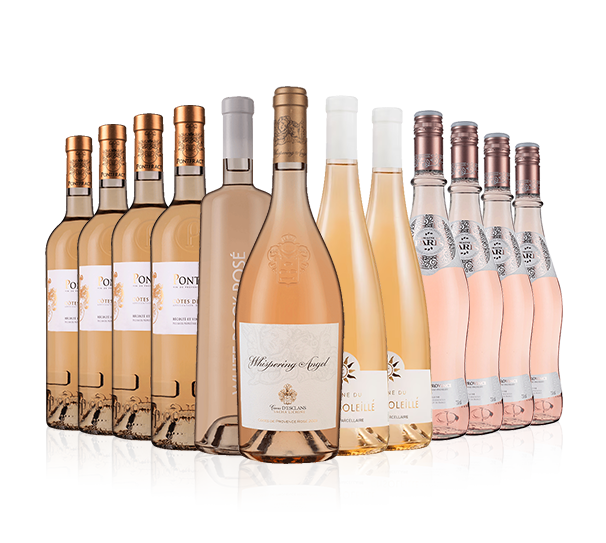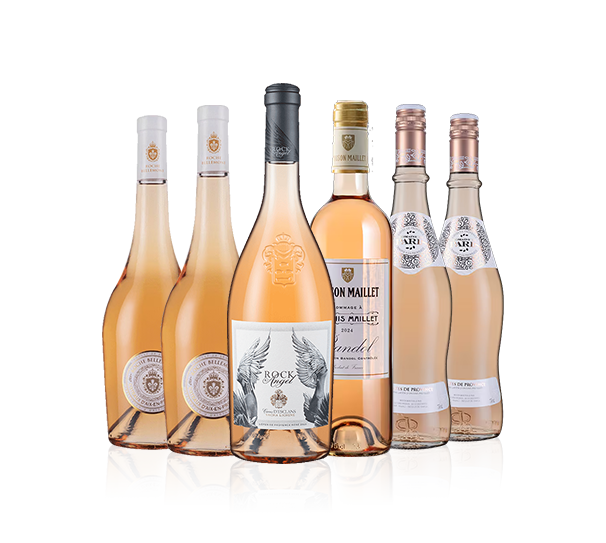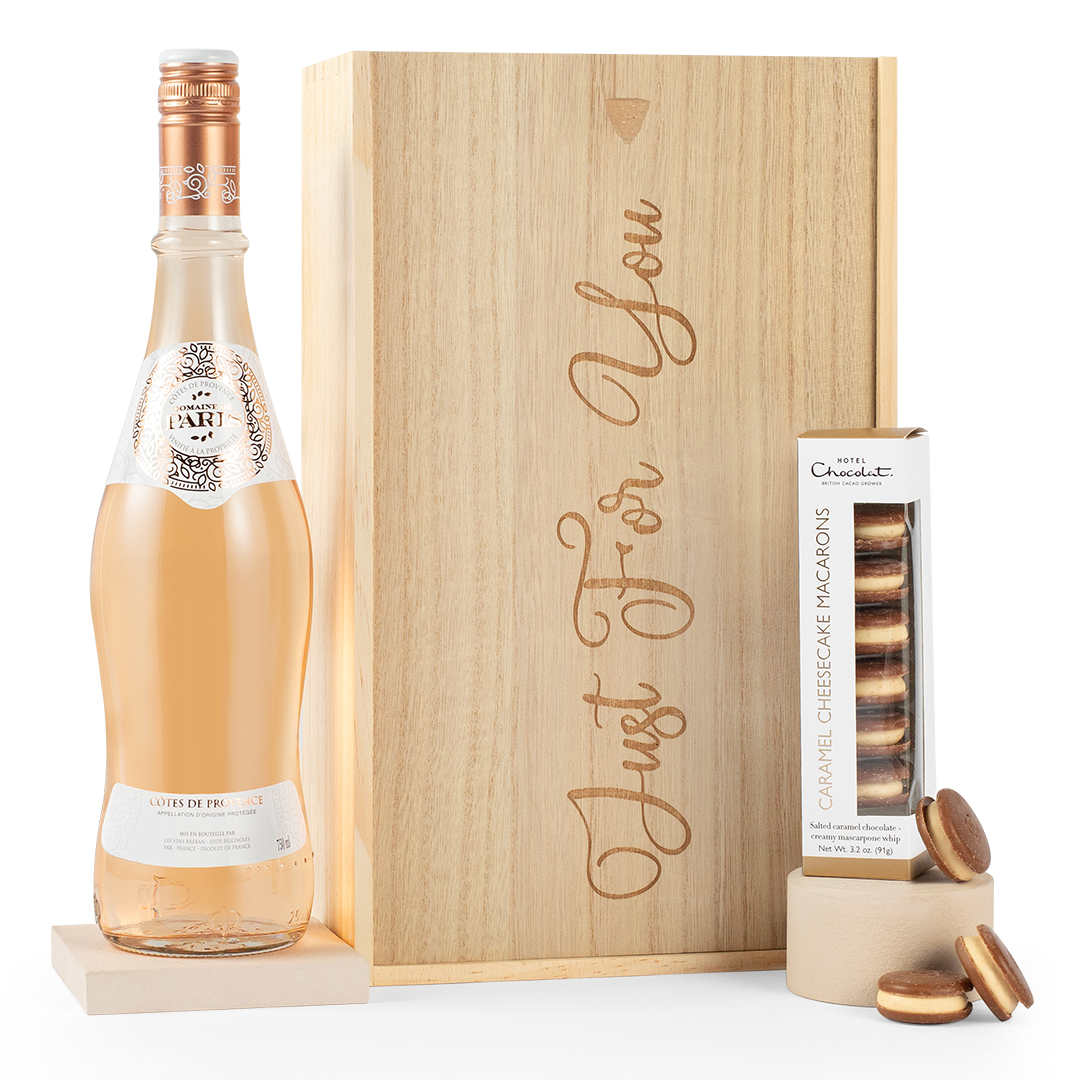Filter by
- Single vineyard, super cuvée of Provence pink – such elegance, subtle fruit and crispness£10.99 per bottleSAVE £4.00
- A superb, pale, crisp rosé from a top Provence appellation and a 4th-generation family estate£16.99 per bottleSAVE £6.01
- Special edition 12-litre bottle of this magnificent rosé from an iconic estate. A party piece!£900.00 per bottle
- Elegant, berry-fruit pink with delightful freshness from France’s top spot for rosé, Provence£10.99 per bottle
- Classy, Provençal estate rosé. Dry and subtle, with delicate berry fruit and zesty freshness£13.99 per bottleSAVE £2.00
- Classic Provençal elegance in this rosé by Monsieur Paul, master of pinks of brightness and charm£11.99 per bottle
- A pale, berry-fresh rosé from a fourth-generation family estate close to Bandol, in Provence£9.99 per bottle
- Racy-fresh Provençal pink with a shimmering streak of minerality that keeps you coming back for more£12.49 per bottle
- From a beautiful Cru Classé family estate in the Côtes de Provence, an elegant, crisp rosé£18.99 per bottle
- Exquisite, pale-hued, herbal-scented Provence rosé, using the very pick of the harvest’s grapes£15.99 per bottleSAVE £3.00
- One of the world's finest rosés from an iconic estate and winemaker. Always utterly ravishing£22.25 per bottle
- Elegant and citrusy, with red berry fruit and subtle seductive spice. This is Provence on top form£16.99 per bottle
- From the home of Whispering Angel comes a rosé with attitude, their finest, supreme racy Rock Angel£26.99 per bottle
- Fine, elegant, fresh berry rosé from the only cellar permitted to put Saint Tropez on the label£13.99 per bottle
- Racy-fresh, wild-herb-scented pale pink rosé from the high Alpine foothills of Provence£9.49 per bottleSAVE £4.50
- Whispering Angel and other Provence luxuries plus FREE bottle worth £18.99£161.88 per caseSAVE £36.26
- Effortlessly elegant Provençal rosé from an award-winning winery – floral with a lovely freshness£13.99 per bottle
- Effortlessly elegant Provençal rosé from an award-winning winery – floral with a lovely freshness£10.49 per bottleSAVE £3.50
- £95.94 per caseSAVE £24.01
- Fresh, fruity sparkling Chardonnay from the south of France, crafted by the Bréban family£9.99 per bottle
- The ultimate combination … a bottle of Provence rosé and salted caramel macarons£30.00
- Showing (1 to 21 of 21)
1
Page 1 of 1
Wine FAQs
Discover Provence wine
Lavender fields, rocky mountain roads, beautiful beaches with azure seas … all these things are synonymous with Provence.
But there’s one colour that stands out amongst the rest here – and that’s pink .
Because Provence is the one region in France where rosé completely dominates. In fact, 88% of wine production in Provence is rosé, with just a tiny amount or red and white.
Provence rosés are typically pale and elegant, with delicate flavours of watermelon, grapefruit, and juicy red fruits. They often have floral or herbal hints and a slight savoury finish. Wild lavender, rosemary, juniper, and thyme grow almost everywhere here, and are said to influence the character of the wines.
What kind of wine is Provence known for?
There’s no denying that Provence sets the bar for quality rosé. Warm, sunny days, cooling Mediterranean breezes and mild winters encourage the sophisticated flavours and pale colours that make Provence pinks extra special.
Provençal pink is elegant, light, and fresh, with a complex aromatic profile that combines floral and fruity aromas of red fruits, exotic fruits, citrus, white flowers, and herbs.
Provence rosé has always been popular with the many tourists that visit the area – but recently it has become even more sought-after thanks to the likes of Whispering Angel and Miraval, the new superstars of the area.
What grapes grow in Provence?
Provence has the perfect climate for grape growing … lots of warm, sunny days, cool evenings, and plenty of Mediterranean breezes.
Provence rosé is typically made from the red grapes: Cinsault, Grenache, Mourvèdre, and Syrah. Cabernet Sauvignon and Carignan are also sometimes used, as well as the local speciality Tibouren.
These varieties are also used for Provence reds – though they’re rarely seen.
The region also produces a small quantity of white wine – typically made from the classic white grape varieties of the Rhône. These include Bourboulenc, Clairette, Grenache Blanc, Marsanne and Viognier. Chardonnay, Sauvignon Blanc, and Semillon and others are sometimes grown here too.
What appellations make up Provence?
Provence is made up of three appellations:
Côtes de Provence
Côtes de Provence is the largest of the three Provence appellations and is home to two of its most famous wines – Miravel and Whispering Angel. The wines are typically floral and fruity, often with a savoury, even balsamic note.
Coteaux d'Aix-en-Provence
Coteaux d'Aix-en-Provence is the western-most Provence wine region. Its rosés are typically made from Grenache, Syrah, Cinsault and Mourvèdre, and tend to be citrus-fresh with delicate raspberry and strawberry fruit. Aix-en-Provence is a top spot for finding great quality at reasonable prices.
Coteaux Varois en Provence
The Coteaux Varois en Provence is the smallest of the three regions – but was the first to begin producing rosés. Like Coteaux d'Aix-en-Provence, it produces refreshing citrusy pinks with summer berry fruit flavours.
Is Provence a dry rosé?
Yes, Provence is known for producing refreshing pale pinks that are dry with delicate fruit flavours.
Rosés from Côtes de Provence have a maximum of four grams of residual sugar per litre – which means they are bone dry. Despite their crisp acidity, Provence rosés remain fruity and round due to the ripeness of the grapes, and cool fermentation, which also helps lock in their floral aromas.
Does Provence produce red and white wines?
Provence does produce both red and white wines, but it's production is quite limited. Red wine production stands roughly at around 9%, while white wine production is just 3%.
What foods pair well with Provence rosé?
Provence rosé is perfect as an aperitif … but it also pairs well with seafood dishes and salads. Being somewhere between a red and a white in character, it can also make an excellent partner to simple white meat dishes.
Some of our favourite pairings include:
- Homemade fishcakes with potato wedges and Tartar sauce
- Salmon and asparagus quiche
- Crispy fried calamari
- Grilled chicken Caesar salad
- Strawberry and spinach salad
- A deckchair and a good book
Interested in the difference between sweet and dry rosé? Learn more in our ‘Is rosé sweet or dry?’ guide .
How to serve Provence wine
You don’t want to over chill a Provence rosé – it could hide those subtle red fruit flavours, and could become more muted.
Instead, serve your Provence rosé just lightly chilled. Aim for a temperature between 7 and 13°C – this is easily achieved by chilling in the fridge for 20 to 30 minutes before serving.
Lightly chilling Provence rosé means you’ll be able to enjoy those delicious berry flavours and floral aromas without them becoming overpowered.
Want to learn more about serving temperatures? Read our wine temperature serving guide.


























